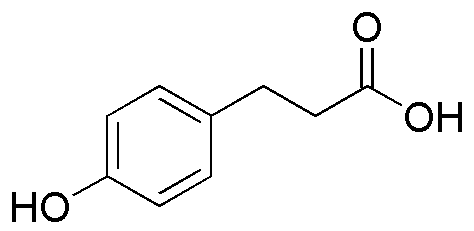3-(4'-Hydroxyphenyl)propionic acid is widely utilized in research focused on:
- Pharmaceutical Development: This compound serves as a key intermediate in the synthesis of various pharmaceuticals, particularly anti-inflammatory and analgesic drugs, enhancing their efficacy and safety profiles.
- Cosmetic Formulations: It is incorporated into skincare products for its antioxidant properties, helping to protect the skin from oxidative stress and improving overall skin health.
- Food Industry: The compound acts as a food preservative and flavor enhancer, contributing to the stability and taste of various food products while ensuring safety and quality.
- Polymer Chemistry: It is used in the production of specialty polymers, providing improved thermal and mechanical properties, which are essential for high-performance materials in various applications.
- Research in Biochemistry: Researchers utilize this compound to study its effects on metabolic pathways and cellular processes, offering insights into potential therapeutic targets for diseases.
General Information
Properties
Safety and Regulations
Applications
3-(4'-Hydroxyphenyl)propionic acid is widely utilized in research focused on:
- Pharmaceutical Development: This compound serves as a key intermediate in the synthesis of various pharmaceuticals, particularly anti-inflammatory and analgesic drugs, enhancing their efficacy and safety profiles.
- Cosmetic Formulations: It is incorporated into skincare products for its antioxidant properties, helping to protect the skin from oxidative stress and improving overall skin health.
- Food Industry: The compound acts as a food preservative and flavor enhancer, contributing to the stability and taste of various food products while ensuring safety and quality.
- Polymer Chemistry: It is used in the production of specialty polymers, providing improved thermal and mechanical properties, which are essential for high-performance materials in various applications.
- Research in Biochemistry: Researchers utilize this compound to study its effects on metabolic pathways and cellular processes, offering insights into potential therapeutic targets for diseases.
Documents
Safety Data Sheets (SDS)
The SDS provides comprehensive safety information on handling, storage, and disposal of the product.
Product Specification (PS)
The PS provides a comprehensive breakdown of the product’s properties, including chemical composition, physical state, purity, and storage requirements. It also details acceptable quality ranges and the product's intended applications.
Certificates of Analysis (COA)
Search for Certificates of Analysis (COA) by entering the products Lot Number. Lot and Batch Numbers can be found on a product’s label following the words ‘Lot’ or ‘Batch’.
*Catalog Number
*Lot Number
Certificates Of Origin (COO)
This COO confirms the country where the product was manufactured, and also details the materials and components used in it and whether it is derived from natural, synthetic, or other specific sources. This certificate may be required for customs, trade, and regulatory compliance.
*Catalog Number
*Lot Number
Safety Data Sheets (SDS)
The SDS provides comprehensive safety information on handling, storage, and disposal of the product.
DownloadProduct Specification (PS)
The PS provides a comprehensive breakdown of the product’s properties, including chemical composition, physical state, purity, and storage requirements. It also details acceptable quality ranges and the product's intended applications.
DownloadCertificates of Analysis (COA)
Search for Certificates of Analysis (COA) by entering the products Lot Number. Lot and Batch Numbers can be found on a product’s label following the words ‘Lot’ or ‘Batch’.
*Catalog Number
*Lot Number
Certificates Of Origin (COO)
This COO confirms the country where the product was manufactured, and also details the materials and components used in it and whether it is derived from natural, synthetic, or other specific sources. This certificate may be required for customs, trade, and regulatory compliance.


